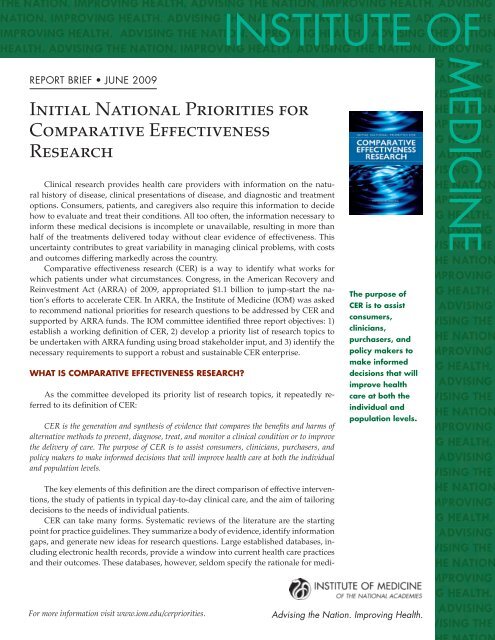Initial National Priorities for Comparative Effectiveness ... - UNM 2020
Initial National Priorities for Comparative Effectiveness ... - UNM 2020
Initial National Priorities for Comparative Effectiveness ... - UNM 2020
You also want an ePaper? Increase the reach of your titles
YUMPU automatically turns print PDFs into web optimized ePapers that Google loves.
REPORT BRIEF • JUNE 2009<br />
<strong>Initial</strong> <strong>National</strong> <strong>Priorities</strong> <strong>for</strong><br />
<strong>Comparative</strong> <strong>Effectiveness</strong><br />
Research<br />
Clinical research provides health care providers with in<strong>for</strong>mation on the natural<br />
history of disease, clinical presentations of disease, and diagnostic and treatment<br />
options. Consumers, patients, and caregivers also require this in<strong>for</strong>mation to decide<br />
how to evaluate and treat their conditions. All too often, the in<strong>for</strong>mation necessary to<br />
in<strong>for</strong>m these medical decisions is incomplete or unavailable, resulting in more than<br />
half of the treatments delivered today without clear evidence of effectiveness. This<br />
uncertainty contributes to great variability in managing clinical problems, with costs<br />
and outcomes differing markedly across the country.<br />
<strong>Comparative</strong> effectiveness research (CER) is a way to identify what works <strong>for</strong><br />
which patients under what circumstances. Congress, in the American Recovery and<br />
Reinvestment Act (ARRA) of 2009, appropriated $1.1 billion to jump-start the nation’s<br />
ef<strong>for</strong>ts to accelerate CER. In ARRA, the Institute of Medicine (IOM) was asked<br />
to recommend national priorities <strong>for</strong> research questions to be addressed by CER and<br />
supported by ARRA funds. The IOM committee identified three report objectives: 1)<br />
establish a working definition of CER, 2) develop a priority list of research topics to<br />
be undertaken with ARRA funding using broad stakeholder input, and 3) identify the<br />
necessary requirements to support a robust and sustainable CER enterprise.<br />
WHAT IS CompArATIve effeCTIveneSS reSeArCH?<br />
As the committee developed its priority list of research topics, it repeatedly referred<br />
to its definition of CER:<br />
CER is the generation and synthesis of evidence that compares the benefits and harms of<br />
alternative methods to prevent, diagnose, treat, and monitor a clinical condition or to improve<br />
the delivery of care. The purpose of CER is to assist consumers, clinicians, purchasers, and<br />
policy makers to make in<strong>for</strong>med decisions that will improve health care at both the individual<br />
and population levels.<br />
The key elements of this definition are the direct comparison of effective interventions,<br />
the study of patients in typical day-to-day clinical care, and the aim of tailoring<br />
decisions to the needs of individual patients.<br />
CER can take many <strong>for</strong>ms. Systematic reviews of the literature are the starting<br />
point <strong>for</strong> practice guidelines. They summarize a body of evidence, identify in<strong>for</strong>mation<br />
gaps, and generate new ideas <strong>for</strong> research questions. Large established databases, including<br />
electronic health records, provide a window into current health care practices<br />
and their outcomes. These databases, however, seldom specify the rationale <strong>for</strong> medi-<br />
For more in<strong>for</strong>mation visit www.iom.edu/cerpriorities.<br />
INSTITUTE OF<br />
The purpose of<br />
Cer is to assist<br />
consumers,<br />
clinicians,<br />
purchasers, and<br />
policy makers to<br />
make in<strong>for</strong>med<br />
decisions that will<br />
improve health<br />
care at both the<br />
individual and<br />
population levels.<br />
Advising the Nation. Improving Health.<br />
MEDICINE
2<br />
The committee<br />
recommends a<br />
balanced portfolio<br />
of research topics<br />
that, collectively,<br />
address broad<br />
societal needs.<br />
cal decisions. Prospective registries and cohort studies are undertaken to understand<br />
the natural progression of disease and the factors that influence clinical outcomes.<br />
These observational research methods have many advantages but cannot escape a key<br />
limitation: characteristics of the patient drive real-life clinical decisions, leading to uncertainty<br />
about whether they, or the intervention itself, cause the observed outcomes.<br />
There<strong>for</strong>e, researchers often turn to randomized controlled trials (RCTs), in which patients<br />
are randomly assigned to different interventions eliminating much of the uncertainty<br />
that plagues the interpretation of observational research. Over time, differences<br />
in response to these interventions reveal which work best and identify factors that<br />
might predict the benefits or harms of an intervention. Although RCTs are considered<br />
the gold standard of evidence, they have shortcomings. Researchers must choose<br />
among these methodologies and must in<strong>for</strong>m the public about their methodological<br />
advantages and shortcomings.<br />
STAKeHoLDer InpUT AnD THe DeveLopmenT of A porTfoLIo of<br />
reSeArCH prIorITIeS<br />
The specific charge to the IOM was to develop a list of high priority research questions<br />
<strong>for</strong> CER to address. The first step was to consult stakeholders. The committee<br />
made more than 20,000 solicitations and received input from direct mail, a public session,<br />
and a web-based questionnaire. At the public session, 54 individuals representing<br />
consumers, patient advocacy groups, provider groups, insurers, manufacturers,<br />
and academia spoke directly to the committee and responded to follow-up questions.<br />
The web-based questionnaire requested nominations, was open <strong>for</strong> 3 weeks, and received<br />
1,758 submissions of more than 2,600 topics.<br />
The committee developed criteria <strong>for</strong> assessing the importance of these recommended<br />
topics and a process <strong>for</strong> prioritization. Criteria included condition-level criteria<br />
(<strong>for</strong> example, burden of disease, cost, and variability) and priority topic-level<br />
criteria (<strong>for</strong> example, appropriateness <strong>for</strong> CER, gaps in existing knowledge, and the<br />
likelihood that the results would improve health). Through three rounds of voting, the<br />
committee narrowed the list to 100 highest-priority research topics (see accompanying<br />
list of priorities by quartile ranking).<br />
The committee recommends a balanced portfolio of research topics that, collectively,<br />
address broad societal needs. To evaluate a topic’s importance, the committee<br />
<strong>for</strong>mulated criteria that would identify not only those diseases and conditions with<br />
the greatest aggregate effect on the health of the U.S. population, but also less common<br />
conditions that severely affect individuals in vulnerable subgroups of the population.<br />
Among the high priority topics were interventions such as disease prevention, systems<br />
of care, drug therapies, devices, surgery, and monitoring of disease.<br />
The priority list includes 29 research areas (see Figure 1), affecting a broad range<br />
of age and ethnicity. Twenty-four of the 100 topics affect special populations. Nominators<br />
felt that RCTs were the most appropriate methodology <strong>for</strong> 49 of the topics, but<br />
also recognized the value of prospective observational studies, database reviews, and<br />
systematic literature reviews <strong>for</strong> studying many research topics.<br />
reCommenDATIonS <strong>for</strong> A roBUST Cer enTerprISe<br />
The committee concludes that the nation’s investment in CER should continue beyond<br />
the conclusion of research on the current priority list of topics. The filling of gaps
in knowledge, the emergence of new disease threats, and the advance of medicine will<br />
require a continuous evaluation of research topic priorities. Regular reporting of the<br />
activities, recommendations, and findings of CER should lead to periodic re-evaluation<br />
of the nation’s CER portfolio.<br />
A sustainable national program of CER will require coordination of private and<br />
public strategies. The program must be accountable to the American people through<br />
periodic progress reports. Moreover, consumers, patients, and caregivers as well as<br />
their health care providers must be involved in all aspects of CER to ensure its relevance<br />
to everyday health care delivery. A large public-private CER enterprise will require<br />
a supporting infrastructure to efficiently move the science <strong>for</strong>ward. In addition to<br />
the capacity to support high-efficiency, pragmatic randomized trials, the program will<br />
require large-scale clinical and administrative data networks that enable observational<br />
studies of patient care while protecting patient privacy and data security. New methods<br />
<strong>for</strong> linking patient-level data from multiple health care organizations will promote<br />
inclusion of populations frequently omitted from clinical trials. The expansion of CER<br />
mandated in ARRA will stress the limited capacity of the current CER work<strong>for</strong>ce, increasing<br />
the need <strong>for</strong> trained experts in biostatistics, epidemiology, systematic reviews,<br />
observational and clinical trials, and more refined research methods <strong>for</strong> CER. The goal<br />
of CER is better decision making by patients and providers. To achieve this, the nation<br />
will need effective strategies <strong>for</strong> disseminating CER findings and promoting their<br />
adoption into clinical practice.<br />
fIgUre 1: DISTrIBUTIon of THe reCommenDeD reSeArCH prIorITIeS<br />
By prImAry AnD SeConDAry reSeArCH AreAS<br />
Number of Priority Topics<br />
60<br />
50<br />
40<br />
30<br />
20<br />
10<br />
0<br />
Health Delivery<br />
Disparities<br />
Disabilities<br />
Cardiovascular<br />
Geriatrics<br />
Psychiatry<br />
Neurology<br />
Pediatrics<br />
Endocrinology<br />
Musculoskeletal<br />
Oncology/Hematology<br />
Women's Health<br />
Substance Abuse<br />
Secondary Research Area<br />
Primary Research Area<br />
Infectious Diseases<br />
Developmental<br />
Rheumatology<br />
Nutrition<br />
Research Area<br />
Dermatology<br />
Figure 5-1<br />
R01311<br />
broadside (landscape)<br />
vector, editable<br />
Complementary/Alternative<br />
EENT<br />
Genetics<br />
Genitourinary<br />
Oral Health<br />
Respiratory<br />
Emergency/Critical Care<br />
Gastrointestinal<br />
Hepatobiliary<br />
End-of-Life Care<br />
Reproduction<br />
The goal of Cer<br />
is better decision<br />
making by<br />
patients and<br />
providers. To<br />
achieve this, the<br />
nation will need<br />
effective strategies<br />
<strong>for</strong> disseminating<br />
Cer findings and<br />
promoting their<br />
adoption into<br />
clinical practice.<br />
3
4<br />
List of Priority toPics by QuartiLe ratings<br />
(disPLay within QuartiLe does not indicate Priority rank).<br />
fIrST QUArTILe<br />
Compare the effectiveness of treatment strategies <strong>for</strong> atrial fibrillation including surgery, catheter<br />
ablation, and pharmacologic treatment.<br />
Compare the effectiveness of the different treatments (e.g., assistive listening devices, cochlear<br />
implants, electric-acoustic devices, habilitation and rehabilitation methods [auditory/oral, sign<br />
language, and total communication]) <strong>for</strong> hearing loss in children and adults, especially individuals<br />
with diverse cultural, language, medical, and developmental backgrounds.<br />
Compare the effectiveness of primary prevention methods, such as exercise and balance training,<br />
versus clinical treatments in preventing falls in older adults at varying degrees of risk.<br />
Compare the effectiveness of upper endoscopy utilization and frequency <strong>for</strong> patients with gastroesophageal<br />
reflux disease on morbidity, quality of life, and diagnosis of esophageal adenocarcinoma.<br />
Compare the effectiveness of dissemination and translation techniques to facilitate the use of<br />
CER by patients, clinicians, payers, and others.<br />
Compare the effectiveness of comprehensive care coordination programs, such as the medical<br />
home, and usual care in managing children and adults with severe chronic disease, especially in<br />
populations with known health disparities.<br />
Compare the effectiveness of different strategies of introducing biologics into the treatment<br />
algorithm <strong>for</strong> inflammatory diseases, including Crohn’s disease, ulcerative colitis, rheumatoid<br />
arthritis, and psoriatic arthritis.<br />
Compare the effectiveness of various screening, prophylaxis, and treatment interventions in<br />
eradicating methicillin resistant Staphylococcus aureus (MRSA) in communities, institutions, and<br />
hospitals.<br />
Compare the effectiveness of strategies (e.g., bio-patches, reducing central line entry, chlorhexidine<br />
<strong>for</strong> all line entries, antibiotic impregnated catheters, treating all line entries via a sterile<br />
field) <strong>for</strong> reducing health care associated infections (HAI), including catheter-associated bloodstream<br />
infection, ventilator associated pneumonia, and surgical site infections, in children and<br />
adults.<br />
Compare the effectiveness of management strategies <strong>for</strong> localized prostate cancer (e.g., active<br />
surveillance, radical prostatectomy [conventional, robotic, and laparoscopic], radiotherapy<br />
[con<strong>for</strong>mal, brachytherapy, proton-beam, and intensity-modulated radiotherapy]) on survival,<br />
recurrence, side effects, quality of life, and costs.<br />
Establish a prospective registry to compare the effectiveness of treatment strategies <strong>for</strong> low<br />
back pain without neurological deficit or spinal de<strong>for</strong>mity.<br />
Compare the effectiveness and costs of alternative detection and management strategies (e.g.,<br />
pharmacologic treatment, social/family support, combined pharmacologic and social/family<br />
support) <strong>for</strong> dementia in community-dwelling individuals and their caregivers.
Compare the effectiveness of pharmacologic and non-pharmacologic treatments in managing<br />
behavioral disorders in people with Alzheimer’s disease and other dementias in home and institutional<br />
settings.<br />
Compare the effectiveness of school-based interventions involving meal programs, vending<br />
machines, and physical education, at different levels of intensity, in preventing and treating<br />
overweight and obesity in children and adolescents.<br />
Compare the effectiveness of various strategies (e.g., clinical interventions, selected social interventions<br />
[such as improving the built environment in communities and making healthy foods<br />
more available], combined clinical and social interventions) to prevent obesity, hypertension, diabetes,<br />
and heart disease in at-risk populations such as the urban poor and American Indians.<br />
Compare the effectiveness of management strategies <strong>for</strong> ductal carcinoma in situ (DCIS).<br />
Compare the effectiveness of imaging technologies in diagnosing, staging, and monitoring patients<br />
with cancer including positron emission tomography (PET), magnetic resonance imaging<br />
(MRI), and computed tomography (CT).<br />
Compare the effectiveness of genetic and biomarker testing and usual care in preventing and<br />
treating breast, colorectal, prostate, lung, and ovarian cancer, and possibly other clinical conditions<br />
<strong>for</strong> which promising biomarkers exist.<br />
Compare the effectiveness of the various delivery models (e.g., primary care, dental offices,<br />
schools, mobile vans) in preventing dental caries in children.<br />
Compare the effectiveness of various primary care treatment strategies (e.g., symptom management,<br />
cognitive behavior therapy, biofeedback, social skills, educator/teacher training, parent<br />
training, pharmacologic treatment) <strong>for</strong> attention deficit hyperactivity disorder (ADHD) in children.<br />
Compare the effectiveness of wraparound home and community-based services and residential<br />
treatment in managing serious emotional disorders in children and adults.<br />
Compare the effectiveness of interventions (e.g., community-based multi-level interventions,<br />
simple health education, usual care) to reduce health disparities in cardiovascular disease, diabetes,<br />
cancer, musculoskeletal diseases, and birth outcomes.<br />
Compare the effectiveness of literacy-sensitive disease management programs and usual care<br />
in reducing disparities in children and adults with low literacy and chronic disease (e.g., heart<br />
disease).<br />
Compare the effectiveness of clinical interventions (e.g., prenatal care, nutritional counseling,<br />
smoking cessation, substance abuse treatment, combinations of these interventions) to reduce<br />
incidences of infant mortality, pre-term births, and low birth rates, especially among African<br />
American women.<br />
Compare the effectiveness of innovative strategies <strong>for</strong> preventing unintended pregnancies (e.g.,<br />
over-the-counter access to oral contraceptives or other hormonal methods, expanding access to<br />
long-acting methods <strong>for</strong> young women, providing free contraceptive methods at public clinics,<br />
pharmacies, or other locations).<br />
5
6<br />
SeConD QUArTILe<br />
Compare the effectiveness of therapeutic strategies (e.g., behavioral or pharmacological interventions,<br />
the combination of the two) <strong>for</strong> different autism spectrum disorders (ASD) at different<br />
levels of severity and stages of intervention.<br />
Compare the effectiveness of the co-location model (psychological and primary care practitioners<br />
practicing together) and usual care (identification by primary care practitioner and referral<br />
to community-based mental health services) in identifying and treating social-emotional and<br />
developmental disorders in children ages 0-3.<br />
Compare the effectiveness of diverse models of comprehensive support services <strong>for</strong> infants and<br />
their families following discharge from a neonatal intensive care unit.<br />
Compare the effectiveness of treatment strategies <strong>for</strong> vascular claudication (e.g., medical optimization,<br />
smoking cessation, exercise, catheter-based treatment, open surgical bypass).<br />
Compare the effectiveness of mindfulness-based interventions (e.g., yoga, meditation, deep<br />
breathing training) and usual care in treating anxiety and depression, pain, cardiovascular risk<br />
factors, and chronic diseases.<br />
Compare the long-term effectiveness of weight-bearing exercise and bisphosphonates in preventing<br />
hip and vertebral fractures in older women with osteopenia and/or osteoporosis.<br />
Compare the effectiveness of shared decision making and usual care on decision outcomes<br />
(treatment choice, knowledge, treatment-preference concordance, and decisional conflict) in<br />
children and adults with chronic disease, such as stable angina and asthma.<br />
Compare the effectiveness of strategies <strong>for</strong> enhancing patients’ adherence to medication regimens.<br />
Compare the effectiveness of patient decision support tools on in<strong>for</strong>ming diagnostic and treatment<br />
decisions (e.g., treatment choice, knowledge acquisition, treatment-preference concordance,<br />
decisional conflict) <strong>for</strong> elective surgical and nonsurgical procedures—especially in<br />
patients with limited English-language proficiency, limited education, hearing or visual impairments,<br />
or mental health problems.<br />
Compare the effectiveness of robotic assistance surgery and conventional surgery <strong>for</strong> common<br />
operations, such as prostatectomies.<br />
Compare the effectiveness (including resource utilization, work<strong>for</strong>ce needs, net health care expenditures,<br />
and requirements <strong>for</strong> large-scale deployment) of new remote patient monitoring<br />
and management technologies (e.g., telemedicine, Internet, remote sensing) and usual care in<br />
managing chronic disease, especially in rural settings.<br />
Compare the effectiveness of diverse models of transition support services <strong>for</strong> adults with<br />
complex health care needs (e.g., the elderly, homeless, mentally challenged) after hospital discharge.<br />
Compare the effectiveness of accountable care systems and usual care on costs, processes of<br />
care, and outcomes <strong>for</strong> geographically defined populations of patients with one or more chronic<br />
diseases.
Compare the effectiveness of different residential settings (e.g., home care, nursing home, group<br />
home) in caring <strong>for</strong> elderly patients with functional impairments.<br />
Compare the effectiveness (including survival, hospitalization, quality of life, and costs) of renal<br />
replacement therapies (e.g., daily home hemodialysis, intermittent home hemodialysis, conventional<br />
in-center dialysis, continuous ambulatory peritoneal dialysis, renal transplantation) <strong>for</strong><br />
patients of different ages, races, and ethnicities.<br />
Compare the effectiveness of treatment strategies (e.g., artificial cervical discs, spinal fusion,<br />
pharmacologic treatment with physical therapy) <strong>for</strong> cervical disc and neck pain.<br />
Compare the effectiveness of film-screen or digital mammography alone and mammography<br />
plus magnetic resonance imaging (MRI) in community practice-based screening <strong>for</strong> breast cancer<br />
in high-risk women of different ages, risk factors, and race or ethnicity.<br />
Compare the effectiveness of new screening technologies (such as fecal immunochemical tests<br />
and computed tomography [CT] colonography) and usual care (fecal occult blood tests and<br />
colonoscopy) in preventing colorectal cancer.<br />
Compare the effectiveness of coordinated care (supported by reimbursement innovations) and<br />
usual care in long-term and end-of-life care of the elderly.<br />
Compare the effectiveness of pharmacologic treatment and behavioral interventions in managing<br />
major depressive disorders in adolescents and adults in diverse treatment settings.<br />
Compare the effectiveness of an integrated approach (combining counseling, environmental<br />
mitigation, chronic disease management, and legal assistance) with a non-integrated episodic<br />
care model in managing asthma in children.<br />
Compare the effectiveness (including effects on quality of life) of treatment strategies (e.g., topical<br />
steroids, ultraviolet light, methotrexate, biologic response modifiers) <strong>for</strong> psoriasis.<br />
Compare the effectiveness of treatment strategies (e.g., cognitive behavioral individual therapy,<br />
generic individual therapy, comprehensive and intensive treatment) <strong>for</strong> Post-traumatic Stress<br />
Disorder stemming from diverse sources of trauma.<br />
Compare the effectiveness and outcomes of care with obstetric ultrasound studies and care<br />
without the use of ultrasound in normal pregnancies.<br />
Compare the effectiveness of birthing care in freestanding birth centers and usual care of childbearing<br />
women at low and moderate risk.<br />
THIrD QUArTILe<br />
Compare the effectiveness of different opioid and non-opioid pain relievers, in different doses<br />
and durations, in avoiding unintentional overdose and substance dependence among subjects<br />
with acute and non-cancer chronic pain.<br />
Compare the effectiveness of aggressive medical management and percutaneous coronary interventions<br />
in treating stable coronary disease <strong>for</strong> patients of different ages and with different<br />
comorbidities.<br />
7
8<br />
Compare the effectiveness of innovative treatment strategies (e.g., cardiac resynchronization,<br />
remote physiologic monitoring, pharmacologic treatment, novel agents such as CRF-2 receptors)<br />
<strong>for</strong> congestive heart failure.<br />
Compare the effectiveness of traditional risk stratification <strong>for</strong> coronary heart disease (CHD) and<br />
noninvasive imaging (using coronary artery calcium, carotid intima media thickness, and other<br />
approaches) on CHD outcomes.<br />
Compare the effectiveness of different treatment strategies (e.g., modifying target levels <strong>for</strong><br />
glucose, lipid, or blood pressure) in reducing cardiovascular complications in newly diagnosed<br />
adolescents and adults with type 2 diabetes.<br />
Compare the effectiveness of acupuncture <strong>for</strong> various indications using a cluster randomized<br />
trial.<br />
Compare the effectiveness of dietary supplements (nutriceuticals) and usual care in the treatment<br />
of selected high-prevalence conditions.<br />
Compare the effectiveness of different treatment options (e.g., laser therapy, intravitreal steroids,<br />
anti-vascular endothelial growth factor [anti-VEGF]) <strong>for</strong> diabetic retinopathy, macular degeneration,<br />
and retinal vein occlusion.<br />
Compare the effectiveness of treatment strategies <strong>for</strong> primary open-angle glaucoma (e.g., initial<br />
laser surgery, new surgical techniques, new medical treatments) particularly in minority populations<br />
to assess clinical and patient-reported outcomes.<br />
Compare the effectiveness and cost-effectiveness of conventional medical management of type<br />
2 diabetes in adolescents and adults, versus conventional therapy plus intensive educational<br />
programs or programs incorporating support groups and educational resources.<br />
Compare the effectiveness of alternative redesign strategies—using decision support capabilities,<br />
electronic health records, and personal health records—<strong>for</strong> increasing health professionals’<br />
compliance with evidence-based guidelines and patients’ adherence to guideline-based regimens<br />
<strong>for</strong> chronic disease care.<br />
Compare the effectiveness of adding in<strong>for</strong>mation about new biomarkers (including genetic<br />
in<strong>for</strong>mation) with standard care in motivating behavior change and improving clinical outcomes.<br />
Compare the effectiveness of different quality improvement strategies in disease prevention,<br />
acute care, chronic disease care, and rehabilitation services <strong>for</strong> diverse populations of children<br />
and adults.<br />
Compare the effectiveness of <strong>for</strong>mulary management practices and usual practices in controlling<br />
hospital expenditures <strong>for</strong> products other than drugs including medical devices (surgical<br />
hemostatic products, radiocontrast, interventional cardiology devices, and others).<br />
Compare the effectiveness of different benefit design, utilization management, and cost-sharing<br />
strategies in improving health care access and quality in patients with chronic diseases (e.g.,<br />
cancer, diabetes, heart disease).<br />
Compare the effectiveness of HIV screening strategies based on recent Centers <strong>for</strong> Disease Control<br />
and Prevention recommendations and traditional screening in primary care settings with<br />
significant prevention counseling.
Establish a prospective registry to compare the effectiveness of surgical and nonsurgical strategies<br />
<strong>for</strong> treating cervical spondylotic myelopathy (CSM) in patients with different characteristics<br />
to delineate predictors of improved outcomes.<br />
Compare the effectiveness of traditional and newer imaging modalities (e.g., routine imaging,<br />
magnetic resonance imaging [MRI], computed tomography [CT], and positron emission tomography<br />
[PET]) when ordered <strong>for</strong> neurological and orthopedic indications by primary care practitioners,<br />
emergency department physicians, and specialists.<br />
Compare the effectiveness of comprehensive, coordinated care and usual care on objective<br />
measures of clinical status, patient-reported outcomes, and costs of care <strong>for</strong> people with multiple<br />
sclerosis.<br />
Compare the effectiveness of treatment strategies <strong>for</strong> obesity (e.g., bariatric surgery, behavioral<br />
interventions, pharmacologic treatment) on the resolution of obesity-related outcomes such as<br />
diabetes, hypertension, and musculoskeletal disorders.<br />
Compare the clinical and cost-effectiveness of surgical care and a medical model of prevention<br />
and care in managing periodontal disease to increase tooth longevity and reduce systemic secondary<br />
effects in other organ systems.<br />
Compare the effectiveness of atypical antipsychotic drug therapy and conventional pharmacologic<br />
treatment <strong>for</strong> Food and Drug Administration-approved indications and compendia-referenced<br />
off-label indications using large datasets.<br />
Compare the effectiveness of management strategies (e.g., inpatient psychiatric hospitalization,<br />
extended observation, partial hospitalization, intensive outpatient care) <strong>for</strong> adolescents<br />
and adults following a suicide attempt.<br />
Compare the effectiveness of different strategies to engage and retain patients in care and to<br />
delineate barriers to care, especially <strong>for</strong> members of populations that experience health disparities.<br />
Compare the effectiveness of topical treatments (e.g., antibiotics platelet-derived growth factor)<br />
and systemic therapies (e.g., negative pressure wound therapy, hyperbaric oxygen) in managing<br />
chronic lower extremity wounds.<br />
foUrTH QUArTILe<br />
Compare the effectiveness of smoking cessation strategies (e.g., medication, individual or quitline<br />
counseling, combinations of these) in smokers from understudied populations such as minorities,<br />
individuals with mental illness, and adolescents.<br />
Compare the effectiveness of computed tomography (CT) angiography and conventional angiography<br />
in assessing coronary stenosis in patients at moderate pretest risk of coronary artery<br />
disease.<br />
Compare the effectiveness of anticoagulant therapies (e.g., low-intensity warfarin, aspirin, injectable<br />
anticoagulants) <strong>for</strong> patients undergoing hip or knee arthroplasty surgery.<br />
Compare the effectiveness of focused intense periodic therapy and usual weekly therapy in<br />
managing cerebral palsy in children.<br />
9
10<br />
Compare the effectiveness of different disease management strategies in improving the adherence<br />
to and value of pharmacologic treatments <strong>for</strong> the elderly.<br />
Compare the effectiveness of care coordination with and without clinical decision supports<br />
(e.g., electronic health records) in producing good health outcomes in chronically ill patients,<br />
including children with special health care needs.<br />
Compare the effectiveness of coordinated, physician-led, interdisciplinary care provided in the<br />
patient’s residence and usual care in managing advanced chronic disease in community-dwelling<br />
patients with significant functional impairments.<br />
Compare the effectiveness of minimally invasive abdominal surgery and open surgical procedures<br />
on post-operative infections, pain management, and recuperative requirements.<br />
Compare the effectiveness of traditional behavioral interventions versus economic incentives<br />
in motivating behavior changes (e.g., weight loss, smoking cessation, avoiding alcohol and substance<br />
abuse) in children and adults.<br />
Compare the effectiveness of diagnostic imaging per<strong>for</strong>med by non-radiologists and radiologists.<br />
Compare the effectiveness of different techniques (e.g., audio, visual, written) <strong>for</strong> in<strong>for</strong>ming patients<br />
about proposed treatments during the process of in<strong>for</strong>med consent.<br />
Compare the effectiveness of different disease management strategies <strong>for</strong> activating patients<br />
with chronic disease.<br />
Compare the effectiveness of different delivery models (e.g., home blood pressure monitors, utilization<br />
of pharmacists or other allied health providers) <strong>for</strong> controlling hypertension, especially<br />
in racial minorities.<br />
Compare the effectiveness of alternative clinical management strategies <strong>for</strong> hepatitis C, including<br />
alternative duration of therapy <strong>for</strong> patients based on viral genomic profile and patient risk<br />
factors (e.g., behavior-related risk factors).<br />
Compare the effectiveness of different treatment strategies in the prevention of progression<br />
and disability from osteoarthritis.<br />
Compare the effectiveness (e.g., pain relief, functional outcomes) of different surgical strategies<br />
<strong>for</strong> symptomatic cervical disc herniation in patients <strong>for</strong> whom appropriate nonsurgical care has<br />
failed.<br />
Compare the effectiveness of different treatment strategies on the frequency and lost productivity<br />
in people with chronic, frequent migraine headaches.<br />
Compare the effectiveness of monotherapy and polytherapy (i.e., use of two or more drugs) on<br />
seizure frequency, adverse events, quality of life, and cost in patients with intractable epilepsy.<br />
Compare the effectiveness of surgical resection, observation, or ablative techniques on diseasefree<br />
and overall survival, tumor recurrence, quality of life, and toxicity in patients with liver metastases.<br />
Compare the effectiveness of hospital-based palliative care and usual care on patient-reported<br />
outcomes and cost.
Compare the effectiveness of different treatment approaches (e.g., integrating mental health<br />
care and primary care, improving consumer self-care, combination of integration and self-care)<br />
in avoiding early mortality and comorbidity among people with serious and persistent mental<br />
illness.<br />
Compare the effectiveness of traditional training of primary care physicians in primary care<br />
mental health and colocation systems of primary care and mental health care on outcomes including<br />
depression, anxiety, physical symptoms, physical disability, prescription substance use,<br />
mental and physical function, satisfaction with the provider, and cost.<br />
Compare the effectiveness of different treatment strategies (e.g., psychotherapy, antidepressants,<br />
combination treatment with case management) <strong>for</strong> depression after myocardial infarction<br />
on medication adherence, cardiovascular events, hospitalization, and death.<br />
Compare the effectiveness of different long-term treatments <strong>for</strong> acne.<br />
Compare the effectiveness of different strategies <strong>for</strong> promoting breastfeeding among low-income<br />
African American women.<br />
11
12<br />
<strong>for</strong> more In<strong>for</strong>mATIon . . .<br />
Copies of <strong>Initial</strong> <strong>National</strong> <strong>Priorities</strong> <strong>for</strong> <strong>Comparative</strong> <strong>Effectiveness</strong> Research are available from the <strong>National</strong> Academies<br />
Press, 500 Fifth Street, N.W., Lockbox 285, Washington, DC 20055; (800) 624-6242 or (202) 334-3313 (in the<br />
Washington metropolitan area); Internet, www.nap.edu. The full text of this report is available at www.nap.edu.<br />
This study was supported by funds from the Agency on Healthcare Research and Quality, the <strong>National</strong> Academies<br />
President’s Fund, and the Robert Wood Johnson Foundation. Any opinions, findings, conclusions, or recommendations<br />
expressed in this publication are those of the author(s) and do not necessarily reflect the views of the<br />
organizations or agencies that provided support <strong>for</strong> this project.<br />
The Institute of Medicine serves as adviser to the nation to improve health. Established in 1970 under the charter<br />
of the <strong>National</strong> Academy of Sciences, the Institute of Medicine provides independent, objective, evidence-based<br />
advice to policymakers, health professionals, the private sector, and the public. For more in<strong>for</strong>mation about the<br />
Institute of Medicine, visit the IOM web site at www.iom.edu.<br />
Permission is granted to reproduce this document in its entirety, with no additions or alterations. Copyright ©<br />
2009 by the <strong>National</strong> Academy of Sciences. All rights reserved.<br />
CommITTee on CompArATIve effeCTIveneSS reSeArCH prIorITIzATIon<br />
HAROLD C. SOX (Co-Chair), Editor, Annals of Internal Medicine, American College of Physicians of Internal<br />
Medicine; SHELDON GREENFIELD (Co-Chair), Professor of Medicine and Executive Director, Center <strong>for</strong> Health<br />
Policy Research, University of Cali<strong>for</strong>nia; CHRISTINE K. CASSEL, President and CEO, American Board of Internal<br />
Medicine; KAY DICKERSIN, Professor of Epidemiology, Director, Center <strong>for</strong> Clinical Trials and U.S. Cochrane<br />
Center, Johns Hopkins School of Public Health; ALAN M. GARBER, Professor of Medicine and Director, Center<br />
<strong>for</strong> Health Policy and Center <strong>for</strong> Primary Care and Outcomes Research, Stan<strong>for</strong>d University; CONSTANTINE<br />
GATSONIS, Professor of Medical Science (Biostatistics) and Director, Center <strong>for</strong> Statistical Sciences, Brown University;<br />
GARY L. GOTTLIEB, President, Brigham and Women’s Hospital; JAMES A. GUEST, President and CEO,<br />
Consumers Union; MARK HELFAND, Professor of Medicine and Director, Oregon Evidence-based Practice Center,<br />
Oregon Health and Science University, and Staff Physician, Portland VAMC; MARIA CAROLINA<br />
HINESTROSA,* Executive Vice President <strong>for</strong> Programs and Planning, <strong>National</strong> Breast Cancer Coalition, Co-<br />
Founder, Nueva Vida; GEORGE J. ISHAM, Medical Director and Chief Health Officer, HealthPartners, Inc.;<br />
ARTHUR A. LEVIN, Director, Center <strong>for</strong> Medical Consumers; JOANN E. MANSON, Professor of Medicine,<br />
Harvard Medical School, Chief of Preventive Medicine, Brigham and Women’s Hospital; KATIE MASLOW,<br />
Director, Policy Development, Alzheimer’s Association; MARK B. MCCLELLAN, Director, Engelberg<br />
Center <strong>for</strong> Health Care Re<strong>for</strong>m, The Brookings Institution; SALLY C. MORTON, Vice President <strong>for</strong> Statistics<br />
and Epidemiology, RTI International; NEIL R. POWE, Chief, Medical Services, San Francisco General Hospital,<br />
Professor and Vice Chairman, Department of Medicine, University of Cali<strong>for</strong>nia; JOE V. SELBY, Director, Division<br />
of Research, Kaiser Permanente; LISA SIMPSON, Director, Child Policy Research Center, Cincinnati Children’s<br />
Hospital Medical Center; SEAN TUNIS, Founder and Director, Center <strong>for</strong> Medical Technology Policy; I. STEVEN<br />
UDVARHELYI, Senior Vice President and Chief Medical Officer, Independence Blue Cross; A. EUGENE<br />
WASHINGTON, Executive Vice Chancellor and Provost, University of Cali<strong>for</strong>nia; JAMES N. WEINSTEIN, Director,<br />
Dartmouth Institute <strong>for</strong> Health Policy and Clinical Practice; Professor and Chair Department of Orthopedic<br />
Surgery, Dartmouth Medical School<br />
STUDy STAff<br />
ROGER HERDMAN, Board Director; ROBERT RATNER, Study Director; JILL EDEN, Senior Program Officer;<br />
DIANNE WOLMAN, Senior Program Officer; SALLY ROBINSON, Program Officer; LAURA LEVIT, Associate<br />
Program Officer; LEA GREENSTEIN, Research Associate; MICHELLE MANCHER, Research Associate;<br />
ALLISON MCFALL, Senior Program Assistant; REDA URMANAVICIUTE, Administrative Assistant;<br />
LEIGHANNE OLSEN, Program Officer; HARRIET CRAWFORD, IT Project Manager; DWAYNE BELL,<br />
Programmer Analyst<br />
ConSULTAnTS<br />
JOSH BENNER, The Brookings Institution; NEIL WEISFELD, New Associates; VICTORIA WEISFELD, New Associates<br />
*Deceased











